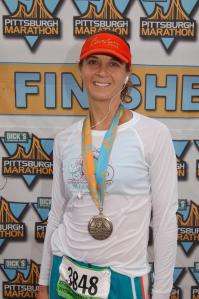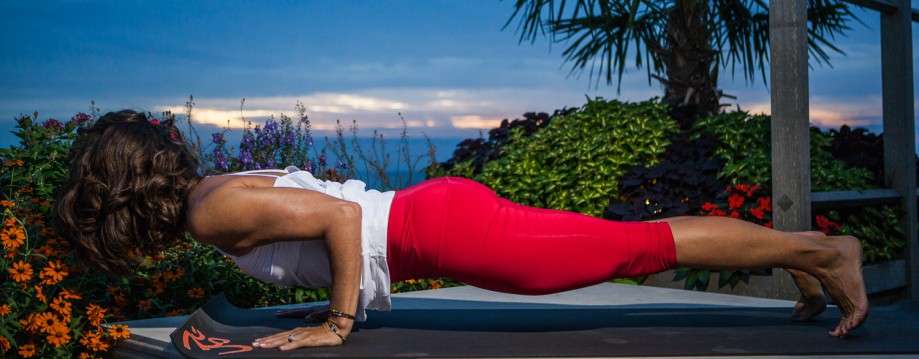When I sat down to write this, I was going to write about my favorite muscle, but I found that I just couldn’t pick one. At a young age, I found I was fascinated by our muscles. I wanted to be a body builder for a period in my late teens, early twenties. Then I moved on to an interest in triathlons, as I was peaked by the idea of multi-sport challenge to the body. Then there were marathons, and then yoga, of course. What I have found is that I have a strong interest to understand my body and to know it’s limits. All of these things that I have tried have required my muscles to be strong. No one muscle would be responsible for all these accomplishments.

Pittsburgh Marathon finish 2010.
The body is a kinetic chain. We are an endless system of links. We are made up of pulleys and levers. You can not affect one muscle alone because of this system. So I thought, if I attempted to pick one muscle as a favorite, I would have had to include all of it’s supporting muscles. Muscles are designed so that when one muscle performs an action, there is an opposing muscle that undoes that action. But, there are also supporting muscles to each muscles main action. I can say that I have a fondness towards the psoas, quadratus lumborum and the serratus anterior. I think why I love these three is because they are not as known to us as the big role players, like the gluteus maximus, quadriceps, hamstrings and biceps, and that they are hard to isolate independently. Which makes them somewhat mysterious and elusive.
Most peoples’ vernacular of muscles is very limited. What I have found through teaching yoga is that most people do not know their hamstrings from their quadriceps. Even if they do, they can not identify the muscles that make up the hamstrings or quadriceps. The name quadriceps is just describing the number of muscles (4) that can be grouped because they perform relatively the same action. It’s not actually the name of the muscles. This lack of knowing our bodies seems unnatural. It’s this body that runs us across a soccer field, or hurdles us through the air to the basketball hoop, or takes us for a walk on a beach. I think most people agree that to lose any bodily function is tragic, whether to lose a limb in war, or suffer paralysis from an automobile accident. I’ve heard people say that they would rather not live then to be paralyzed. But there is a slow paralysis and limb loss going on each day inside our bodies, because we are not using them. This paralysis is so subtle that it doesn’t seem to cause much alarm.
That might seem like a stretch to some, but I have seen it because I’m looking closely. Our bodies are initially designed for us to be able to touch our toes easily. As the years pass we begin to lose that ability, and before we recognize it we can’t reach our toes anymore. This is sometimes why old people no longer wear shoes that need tying, slip-ons it is. Or they can no longer put on shirts that need pulled over their heads, just button-ups now. Or they can no longer walk up stairs: they can not raise their foot 10 inches to take that step. Do you see that loss of ability the way I do, as a form of paralysis? Seems tragic. Should we just accept these things as a natural course for the body we are in? To some degree, but more and more people are losing their independence and freedom at a younger age.
Most people only become involved with their bodies when they are no longer working properly? Doesn’t that seem too late? I heard this description of the quality of our bodies – that the more supple they are, the more life there is in it. And the more rigid or stiff, the less life there is. When we are born, we are soft and flexible. And when we die, we are stiff and brittle. So it would seem, that it would be wise to stay flexible and soft. Movement is the medicine necessary.
Range of motion is the key to youthfulness. The less we engage our muscles to their designed potential, the more we lose of their ability. Even with exercise, which is great movement, it’s not enough. The healthiest form of exercise is the kind that continues to gradually take us out of our comfort zone. You have to leave your comfort zone in order for something new to be experienced and gained. If we are constantly repeating the same regimen, then we are creating a pattern of ROM that will only fit that specific activity. If we experience new movements, then we are constantly expanding our capabilities and increasing our range of motion. The greater the range the less paralyzed the muscle movement.
There are two essential things to understand about movement of our muscles: they can create movement as well as resist against it. Think of two men arm wrestling as a perfect example. In order for our beautiful muscles to stay healthy, young and supple, they must be as equally strong as they are flexible. That’s what’s so beautiful about yoga. Body building made me strong. Triathlons made me adaptable with my strength. Marathons made my mind strong and my endurance endless. But yoga balanced my body’s strength and flexibility optimally, particularly because I practice Ashtanga yoga, with it’s never ending series of difficulty. Just when you master one pose that you have spent 6 months working on, a new harder variation of it is waiting in the wings. Yoga uses all the muscles we have to their fullest range of motion. I’m still a fan of running mixed in with my yoga, as yoga can never quiet get us the same cardiovascular work as running or biking does. It does a pretty good job, surprisingly, if practiced in a vinyasa (flowing) style.
Muscles, are beautiful and so resilient. They move our skeleton. They pump blood back to the heart. They can grow bigger or smaller, they can retract and be short and tight, or they can release and be long and flexible. They can swim you across a lake. They can cartwheel you in the grass on a sunny day. They can engage to bring you upright or they can release so you can lie down. They can weaken if you don’t use them, they can strengthen when you do. They are responsive, adaptable, graceful, artistic, and under appreciated. The way I show my appreciation is to use them, to push them, to heal them, and to know them. 656 muscles is the average in the human body. I don’t know them all by name yet, but I hope to. I’m pretty sure I have felt all of them and used them, strengthen them, weakened them, injured them, and healed them, all.
My love affair grows each time I am on my mat, because everyday my body responds differently. Which keeps it interesting. What seems like the unpredictable nature of our bodies is not as unpredictable as we think. We just aren’t looking often enough, and deep enough at our bodies to hear loud and clear what our bodies want, and what they are capable of. Let’s not wait until the paralysis becomes apparent. All the information you need about your body is available to you every day. No doctor, pill, or apparatus necessary, just movement. Movement is the medicine, your body is the apparatus and your breath is the pill. Doctor’s orders, oops, I mean yoga teacher orders… move your body to it’s fullest potential everyday and adapt to the change in your potential everyday. While your at it, maybe try and figure out where your psoas is, how your quadratus lumborum works and what is your serratus anterior doing for you. Or better yet, pick your own muscles that amaze you and move you. Good luck.
